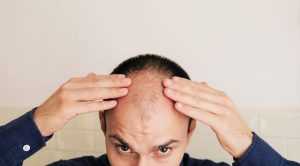RNA therapy, also known as ribonucleic acid therapy, is a cutting-edge and emerging technique in the realm of hair loss treatment. By targeting the molecular pathways involved in hair growth, this therapy stimulates the hair follicles, encouraging the production of new hair. However, it is important to note that human trials are still required to validate its effectiveness, according to Dr. Radhika Raheja, a Consultant in Dermatology and Hair Transplant at Metro Hospital, Faridabad.

Androgenetic alopecia, commonly referred to as male or female pattern baldness, remains a challenging condition to effectively treat. The hair cycle in humans is a complex process influenced by multiple factors, and disruptions to this cycle can result in hair loss. Hormonal changes, genetics, and aging are among the primary causes.
While there are affordable and safe treatment options available for androgenetic alopecia, such as oral finasteride, topical minoxidil, growth factor concentrate-platelet rich plasma (GFC PRP), and hair transplant by follicular unit extraction (FUE), the necessity for developing costly and dubious treatments seems unnecessary.
The utilization of micro RNA delivery systems has always intrigued researchers as a potential treatment for various diseases, although the outcomes have varied. RNA(ribonucleic acid) therapy, is an emerging approach in the field of hair loss treatment. This therapy functions by targeting the molecular pathways involved in hair growth and stimulating the hair follicles to generate new hair. Although the exact mechanism of action is still being investigated, initial research has demonstrated promising results.
One concern regarding micro RNA therapy pertains to the mode of penetration and absorption into the target cells. While it does stimulate the growth of existing hair by activating stem cells, it does not induce new hair growth.
Researchers from Northwestern University have introduced a new technique that softens hair follicles, making them more flexible and conducive to growth. By enhancing the production of a small RNA particle called miR-205, the cells’ hardness is relaxed. Rui Yi, a professor of pathology and dermatology at Northwestern’s Feinberg School of Medicine and a senior author of the study, stated, “They started to grow hair in 10 days.” He further explained that this technique does not generate new stem cells but stimulates the existing stem cells to promote hair growth.
It is important to note that this research was conducted on a mouse model, and the response may not necessarily translate directly to humans. Therefore, it is premature to determine the efficacy or benefits of these studies. Nonetheless, there is optimism.
In comparison to male pattern baldness, there are fewer effective treatment options available for female pattern baldness. This is where Ribonucleic acid therapy could potentially offer a valuable treatment for hair loss in females. However, it is crucial to acknowledge that this approach is still in its early stages of development, and further research is required to establish its safety and efficacy in humans. Nevertheless, RNA therapy holds tremendous potential as a novel treatment option for hair loss.
It is important to recognize that hair loss can have different underlying reasons, and not all types of hair loss will necessarily improve with RNA therapy or other treatments. It is essential to consult with a healthcare provider or dermatologist to obtain personalized advice and recommendations for the treatment of hair loss.
